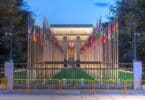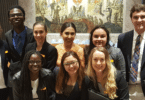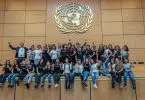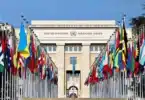While the media and popular culture may portray refugee camps mainly as places of desperation, human rights workers know that they are complex communities teeming with economic, social, and artistic life. Social-justice oriented theater professionals have found refugee camps to be a vital and vibrant place to practice their craft. Theater workshops are welcome breaks from the monotony of camp life and can be a much-needed opportunity for storytelling, cultural expression, and personal reflection. This work has increased in recent decades, with established refugee theater projects in France, Germany, Greece, Kenya, and Palestine just to name a few.
But like any human rights or social justice work, refugee theater projects must be culturally sensitive and ethically-responsible. Much of the current work owes a debt to the scholarship of Dwight Conquergood, a professor of Performance Studies and theater professional. His influential essay “Health Theatre in a Hmong Refugee Camp” detailed theatrical strategies and cross-cultural best practices that have been used to teach generations of theater and human rights professionals.
The essay is based on his work in 1985 at Refugee Camp Ban Vinai, Thailand. The camp was home to over 45,000 Hmong and other highland refugees who had fled Communist rule in neighboring Laos. Interestingly, Conquergood did not enter the camp as part of a theater program. At the time, the political situation in Thailand was considered unstable and the camps were closed to outside researchers. Conquergood was instead hired by the International Rescue Committee as part of their environmental health education program. He served as an ethnographic consultant and was tasked with developing programs to improve health and hygiene at the camp.
Rather than seeing the refugee camp as a place of lack or absence, Conquergood recognized that performance was already happening all around, including storytelling, folk singing, drumming, incense burning, lamentations for the dead, and shamanic practices. Refugee camps are rich with performance because displaced peoples must work hard to preserve their culture and way of life. Performance is a way to reconstitute their communities and add stability to the uncertainty of their daily lives. Performance is also a flexible medium and stories, songs, and dances can easily be altered to incorporate new material and reflect new surroundings. In short, performance is the perfect way to integrate an old way of life with a new reality.
Conquergood’s goal was to design health programming that was based around native beliefs and values that communicated to the residents in culturally appropriate ways. To do this, he drew on Hmong folklore, proverbs, stories, and songs to produce street performances using large puppets and animal sculptures. This imagery was already familiar to the camp residents and helped communicate his message. For example, a performance designed to increase awareness of rabies vaccines for camp dogs used a performer dressed as a chicken to deliver the informative message. While this might have seemed strange to Western camp workers, it made perfect sense to the residents. In Hmong culture, chickens are associated with powers of divination because they are the first to know when the sun comes up in the morning. Having a chicken character spread the message about rabies vaccines was both entertaining and persuasive.
However, any performance approach in which local knowledge is used by outsiders runs the risk of appropriate that local culture or using it as a tool for domination. Conquergood did not want to use community traditions to simply make residents submit unthinkingly to the demands of the camp administration. Instead he wanted his performances to be methods for developing “critical awareness.” In other words, he wanted to show the refugees new ways of thinking about their surroundings that would, in turn, help them choose to transform their behaviors. When trash became a problem in the camp, Conquergood and his performers built a giant puppet that they called Mother Clean who sang songs about health and sanitation. In their mountain homeland, the Hmong were accustomed to throwing their food waste out into nature where it would quickly become fertilizer or animal feed. But now that they were living in an incredibly dense refugee camp, these traditional practices were no longer sanitary. Rather than denigrating the refugees as dirty, the playful Mother Clean helped them think about their surroundings in a new way so they could independently choose a healthier lifestyle.
For these theater approaches to be effective, Conquergood was committed to what he called a “dialogical exchange,” an orientation of give-and-take in which every participant has something to teach as well as something to learn. Conquergood modeled this practice in his daily life as well as in his theater work. He respected the traditional Hmong healers and used their folk remedies for things like stomach ailments and small lacerations. But when he got more severely ill with Dengue fever, however, he sought treatment in a hospital in Singapore. After he returned to the camp, Conquergood found that the refugees, who were normally skeptical of Western medicine, exhibited great interest in his hospital treatment. Because Conquergood respected their traditions and techniques they were more willing to learn about his.
Toward the end of his essay Conquergood identifies some of the limits of his work in the Camp Ban Vinai. While he had great success with his performances for the refugees, he began to realize that the health professionals and human rights workers needed a similar kind of “consciousness-raising.” The camp workers wanted the Hmong to conform to their Western standards of cleanliness and order but were not interested in understanding the Hmong way of life. As a result, the Hmong were hesitant to seek out help or support from any of the camp aid workers. While human rights training has certainly evolved since Conquergood did his work in the 1980’s, it’s important to remember that it is not only refugees that can benefit from camp theater programs. These performances can build a bridge of understanding not only amongst the refugees themselves but also across cultures. More than entertainment or escape, theater can build community, foster understanding, and bring about real change.
Conquergood, Dwight. “Health Theatre in a Hmong Refugee Camp: Performance, Communication, and Culture.” TDR (1988-) 32, no. 3 (1988): 174-208.












